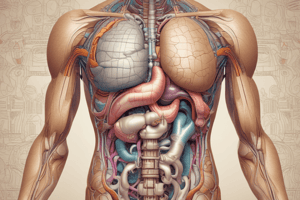Podcast
Questions and Answers
What is the primary function of the organs of the alimentary canal?
What is the primary function of the organs of the alimentary canal?
- To regulate body temperature
- To eliminate waste from the body
- To produce hormones
- To nourish the body (correct)
What is the length of the alimentary canal during life?
What is the length of the alimentary canal during life?
- 12 meters (40 feet)
- 7.62 meters (25 feet) (correct)
- 10 meters (33 feet)
- 5 meters (16 feet)
What is the role of salivary amylase in the digestive process?
What is the role of salivary amylase in the digestive process?
- Breaking down fats
- Breaking down vitamins
- Breaking down starch (correct)
- Breaking down proteins
What is the name of the muscular tube that connects the mouth to the stomach?
What is the name of the muscular tube that connects the mouth to the stomach?
What is the end point of the digestive system?
What is the end point of the digestive system?
What is the primary function of the stomach in the digestive system?
What is the primary function of the stomach in the digestive system?
Which organ is responsible for the majority of nutrient absorption in the digestive system?
Which organ is responsible for the majority of nutrient absorption in the digestive system?
What is the role of the liver in the digestive system?
What is the role of the liver in the digestive system?
Which enzyme breaks down starch in the mouth, starting the process of chemical digestion?
Which enzyme breaks down starch in the mouth, starting the process of chemical digestion?
What is the function of the pancreas in the digestive system?
What is the function of the pancreas in the digestive system?
Flashcards are hidden until you start studying
Study Notes
The Digestive System: Breaking Down Food for Nutrient Absorption
The digestive system is a complex network of organs and glands that work together to break down ingested food into nutrients, which are then absorbed into the bloodstream. These nutrients are essential for providing energy, growth, and maintenance of the body's tissues. The digestive system is divided into two main categories: the organs of the alimentary canal and the accessory digestive organs.
Alimentary Canal Organs
The alimentary canal, also known as the gastrointestinal tract or the gut, is a one-way tube that extends from the mouth to the anus. It is approximately 7.62 meters (25 feet) in length during life and around 9 meters (30 feet) long when smooth muscle tone is lost. The main function of the organs of the alimentary canal is to nourish the body. The tract begins at the mouth and ends at the anus. Along the way, it is modified as the pharynx, esophagus, stomach, and small and large intestines to fit the functional needs of the body.
-
Mouth: The mouth is the starting point of the digestive system. It is where food enters the body, and the teeth and tongue begin the process of mechanical digestion. The salivary glands also start the chemical digestion of food by releasing saliva, which contains the enzyme salivary amylase, which breaks down starch.
-
Esophagus: The esophagus is a muscular tube that connects the mouth to the stomach. Swallowing pushes chewed food into the esophagus, and peristalsis, a series of muscular contractions, transports food through the rest of the system.
-
Stomach: The stomach is a muscular sac that secretes gastric juice, which contains hydrochloric acid and the enzyme pepsin. These substances begin the process of breaking down proteins and killing potentially harmful bacteria. After about an hour or two, a thick semi-liquid paste, called chyme, forms and enters the small intestine.
-
Small Intestine: The small intestine is a 20-foot (6-meter) tube-shaped organ where the majority of nutrient absorption occurs. The walls of the small intestine contain absorptive cells that take up the nutrients from the chyme and transport them into the bloodstream. The liver and pancreas release secretions into the small intestine to aid in the digestion of food.
-
Large Intestine (Colon): The large intestine, also known as the colon, absorbs water and electrolytes from the undigested food material and stores waste products. It is divided into three main parts: the cecum, the ascending colon, the transverse colon, the descending colon, the sigmoid colon, and the rectum. The rectum stores waste before it is excreted through the anus.
Accessory Digestive Organs
Accessory digestive organs are essential for the breakdown of food and the absorption of nutrients. They include:
-
Salivary Glands: The salivary glands produce saliva, which contains the enzyme salivary amylase. This enzyme breaks down starch in the mouth, starting the process of chemical digestion.
-
Gallbladder: The gallbladder stores bile, which is produced by the liver. Bile helps to emulsify fats, making them more accessible to digestive enzymes.
-
Liver: The liver produces bile, which is released into the small intestine. It also creates glycogen from sugars and converts dietary proteins into new proteins and amino acids.
-
Pancreas: The pancreas produces digestive enzymes, such as amylase, protease, and lipase, which are released into the small intestine to aid in the digestion of carbohydrates, proteins, and fats.
Summary
The digestive system is a complex network of organs and glands that work together to break down food into nutrients, which are then absorbed into the bloodstream for the body's use. The alimentary canal organs, including the mouth, esophagus, stomach, small intestine, and colon, form a one-way tube that begins at the mouth and ends at the anus. Accessory digestive organs, such as the salivary glands, gallbladder, liver, and pancreas, aid in the breakdown of food and the absorption of nutrients. These organs function cooperatively with other body systems, including the cardiovascular, endocrine, and lymphatic systems, to ensure the efficient procurement, digestion, and uptake of nutrients.
Studying That Suits You
Use AI to generate personalized quizzes and flashcards to suit your learning preferences.




